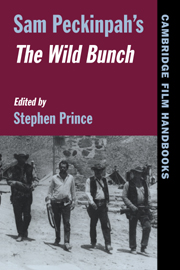Book contents
- Frontmatter
- Contents
- List of Contributors
- Introduction: Sam Peckinpah, Savage Poet of American Cinema
- 1 The Wild Bunch: The Screenplay
- 2 Peckinpah the Radical:The Politics of The Wild Bunch
- 3 “Back Off to What?” Enclosure, Violence, and Capitalism in Sam Peckinpah's The Wild Bunch
- 4 Ballistic Balletics: Styles of Violent Representation in The Wild Bunch and After
- 5 Re-Visioning the Western: Code, Myth, and Genre in Peckinpah's The Wild Bunch
- 6 The Wild Bunch: Innovation and Retreat
- Reviews and Commentary
- Filmography
- Select Bibliography
- Index
3 - “Back Off to What?” Enclosure, Violence, and Capitalism in Sam Peckinpah's The Wild Bunch
Published online by Cambridge University Press: 29 December 2009
- Frontmatter
- Contents
- List of Contributors
- Introduction: Sam Peckinpah, Savage Poet of American Cinema
- 1 The Wild Bunch: The Screenplay
- 2 Peckinpah the Radical:The Politics of The Wild Bunch
- 3 “Back Off to What?” Enclosure, Violence, and Capitalism in Sam Peckinpah's The Wild Bunch
- 4 Ballistic Balletics: Styles of Violent Representation in The Wild Bunch and After
- 5 Re-Visioning the Western: Code, Myth, and Genre in Peckinpah's The Wild Bunch
- 6 The Wild Bunch: Innovation and Retreat
- Reviews and Commentary
- Filmography
- Select Bibliography
- Index
Summary
Approximately thirty minutes into The Wild Bunch, after the disastrous Starbuck job, Pike, obviously weary of his outlaw existence, says to Dutch, “I'd like to make one good score and back off.” When Dutch replies, “Back off to what?” we see the core of Peckinpah's intent in the film: to depict the outlaw's violent, materialistic life as a dead end. Indeed, almost from its opening moments, The Wild Bunch deals with images of enclosure that suggest a sense of finality. A feeling of enclosure is created when the Bunch ride into Starbuck, where they are surrounded on all sides by bounty hunters, and it is repeated in other actions in the film: during the initial entrance of the Bunch into Agua Verde, the delivery of guns to Mapache's henchman in a canyon, and the final Shootout in Agua Verde. What all of these scenes of enclosure naturally involve is the notion of space both as a physical construct and as a metaphor for various kinds of limitation or entrapment. Given Peckinpah's masterful dramatization in the film of significant themes such as loyalty, friendship, and honor, along with The Wild Bunch's continuing influence as a film notable for its breakthrough representational techniques, I think it would be productive to investigate The Wild Bunch's use of space with regard to how it relates to some of the film's major concerns: memory, interpersonal relations, and the influence that money exerts on human behavior.
Let's take a few preliminary examples of the enclosure motif as it emerges early in the film.
- Type
- Chapter
- Information
- Sam Peckinpah's The Wild Bunch , pp. 105 - 129Publisher: Cambridge University PressPrint publication year: 1998

